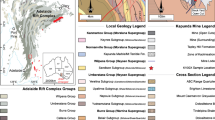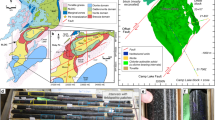Abstract
The Paiting gold deposit, Guizhou Province, China, has been regarded as a Carlin-type gold deposit by several researchers. Alteration and ore-related minerals from the Paiting deposit were examined, and results were compared with the Cortez Hills Carlin-type gold deposit, Nevada, USA. Similarities include the structural and stratigraphic controls on the orebodies in both deposits and the occurrence of invisible gold ionically bound in arsenian pyrite. Significant differences include the following: (1) The gold-bearing mineral in Nevada is arsenian pyrite. However, gold-bearing minerals in the Paiting deposit include arsenopyrite, arsenian pyrite, and trace pyrrhotite. Also, euhedral or subhedral gold-bearing arsenian pyrite at Paiting contains significantly less As, Cu, and Hg than gold-bearing pyrite from Nevada. (2) Alteration in the Paiting deposit displays significantly less decarbonatization. Instead, dolomite precipitation, which has not been described in Nevada deposits, is associated with deposition of gold-bearing sulfide minerals. (3) Stibnite and minor native antimony typify Paiting late-ore-stage minerals, whereas in Nevada, realgar, orpiment, and calcite are common late-ore-stage minerals. Precipitation of native antimony in the Paiting deposit reflects the evolution of a late-ore fluid with unusually low sulfur and oxygen fugacities. Some characteristics of the Paiting gold deposit, including formation of ore-stage dolomite and precipitation from CO2-rich ore fluids at temperatures in excess of 250 °C, are more typical of orogenic deposits than Nevada Carlin deposits. The presence of similarities in the Paiting deposit to both Carlin type and orogenic deposits is consistent with formation conditions intermediate to those typical of Carlin type and orogenic systems.











Similar content being viewed by others
References
An F, Zhu YF (2010) Native antimony in the Baogutu gold deposit (west Junggar, NW China): its occurrence and origin. Ore Geol Rev 37:214–223
Arbonies DG, Creel KD, Jackson ML (2011) Cortez hills lower zone discovery and geologic update. In: Steininger R, Pennell B (eds) Great basin evolution and metallogeny. Geological Society of Nevada Symposium Volume, Reno, pp 447–462
Arehart GB (1996) Characteristics and origin of sediment-hosted gold deposits: a review. Ore Geol Rev 11:383–403
Barnes HL (1979) Solubilities of ore minerals. In: Barnes HL (ed) Geochemistry of hydrothermal ore deposits, 2nd edn. University Park, Pennsylvania, pp 404–460
Barrick Gold Corporation (2014) Barrick reports fourth quarter and full year 2014 results.http://www.barrick.com/investors/news/news-details/2015/Barrick-Reports-Fourth-Quarter-and-Full-Year-2014-Results/default.aspx
Bellot JP (2003) The Biards Sb-Au bearing zone (Massif Central, France): an indicator of crustal-scale transcurrent tectonics guiding late Variscan collapse. Econ Geol 98:1427–1447
Cail T, Cline JS (2001) Alteration associated with gold mineralization at the Getchell Carlin-type gold deposit, northern Nevada, USA. Econ Geol 96:1343–1359
Chen MH, Mao JW, Bierlein FP, Norman T, Uttley PJ (2011) Structural features and metallogenesis of the Carlin-type Jinfeng (Lannigou) gold deposit, Guizhou Province, China. Ore Geol Rev 43:217–234
Clark L (2012) Ore and gangue mineral paragenesis of the Cortez Hills Carlin-type gold deposit, Nevada: evidence for coincident high-grade gold deposition and collapse brecciation. Dissertation, University of Nevada Las Vegas
Cline JS, Hofstra AH (2000) Ore-fluid evolution at the Getchell Carlin-type gold deposit, Nevada, USA. Eur J Mineral 12:195–212
Cline JS, Hofstra AH, Muntean JL, Tosdal RM, Hickey KA (2005) Carlin-type gold deposits in Nevada: critical geologic characteristics and viable models. In: Hedenquist JW, Thompson JFH, Goldfarb RJ, Richards JP (eds) Economic geology 100th anniversary volume. Society of Economic Geologists, Inc, Littleton, pp 451–484
Cline JS, Muntean JL, Gu XX, Xia Y (2013) A comparison of Carlin-type gold deposits: Guizhou province, golden triangle, southwest China, and northern Nevada, USA. Earth Sci Front 20:1–18
Dong GG (2007) Geological characteristics of the Paiting gold deposit in Southeast Guizhou. Acta Miner Sin (supl.): 96–97 (in Chinese)
Fan EC (2010) Ore-controlling factors and prospecting direction of Paiting gold deposit in Danzhai, Guizhou. Acta Geol Sin 24:322–327 (in Chinese with English abstract)
Gao ZM, Li HY, Yang ZS, Tao Y, Luo TY, Liu XF, Xia Y, Rao WB (2002) Metallogenic and ore prospecting of the main gold deposits, Guizhou Province and Yunnan Province. Geological Publishing House, Beijing (in Chinese with English abstract)
Goldfarb RJ, Baker T, Dube B, Groves DI, Hart CJR, Gosselin P (2005) Distribution, character and genesis of gold deposits in metamorphic terranes. In: Hedenquist JW, Thompson JFH, Goldfarb RJ, Richards JP (eds) Economic geology 100th anniversary volume. Society of Economic Geologists, Inc, Littleton, pp 407–450
Groves DI, Goldfarb RJ, Gebre-Mariam M, Hagemann SG, Robert F (1998) Orogenic gold deposits: a proposed classification in the context of their crustal distribution and relationship to other gold deposit types. Ore Geol Rev 13:7–27
Hofstra AH, Cline JS (2000) Characteristics and models for Carlin-type gold deposits. In: Hagemann SG, Brown PE (eds) Gold in 2000. Reviews in economic geology. Society of Economic Geologists Inc, Littleton, pp 163–220
Hofstra AH, Leventhal JS, Northrop HR, Landis GP, Rye RO, Birak DJ, Dahl AR (1991) Genesis of sediment-hosted disseminated gold deposits by fluid mixing and sulfidization: chemical-reaction-path modeling of ore-depositional processes documented in the Jerritt Canyon district, Nevada. Geology 19:36–40
Hofstra AH, Snee LW, Rye RO, Folger HW, Phinisey JD, Loranger RJ, Dahl AR, Naeser CW, Stein HJ, Lewchuk M (1999) Age constraints on Jerritt Canyon and other Carlin-type gold deposits in the western United States: relationship to mid-tertiary extension and magmatism. Econ Geol 94:769–802
Hu RZ, Su WC, Bi XW, Tu GZ, Hofstra AH (2002) Geology and geochemistry of Carlin-type gold deposits in China. Miner Deposita 37:378–392
Humphreys ED (1995) Post Laramide removal of the Farallon slab, western United States. Geology 23:987–990
Jackson M, Arbonies D, Creel K (2011) Architecture of the Cortez hills breccia body. In: Steininger R, Pennell B (eds) Great basin evolution and metallogeny. Geological Society of Nevada Symposium Volume, Reno, pp 14–22
Krupp RE (1988) Solubility of stibnite in hydrogen sulfide solutions speciation and equilibrium constants from 25 to 350°C. Geochim Cosmochim Acta 52:3005–3015
Krupp RE, Seward TM (1990) Transport and deposition of metals in the Rotokawa geothermal system, New Zealand. Miner Deposita 25:73–81
Li HY, Gao ZM, Yang ZS, Luo TY, Rao WB (2002) Geochemical characteristics of the Carlin-type gold deposits in Danzhai, Guizhou (in Chinese). Chin J Geol 37:1–7 (in Chinese with English abstract)
Li CY, Liu YP, Zhang Q, Pi DH, Zhang WL, Chen J (2005) Discovery of antimony and distribution on characteristics of associated elements in Huize Pb-Zn deposit. Mineral Deposita 24:52–60 (in Chinese with English abstract)
Liu JJ, Yang D, Liu JM, Liu ZJ, Yang Y, Mao GJ, Zhen MH (2007) Mineralogical characteristics of native arsenic and tracing the metallogenic physicochemical condition in Carlin-type gold deposits. Earth Sci Front 14:158–166 (in Chinese with English abstract)
Lubben JD, Cline JS, Barker SLL (2012) Ore fluid properties and sources from quartz-associated gold at the Betze-Post Carlin-type gold deposit, Nevada, United States. Econ Geol 107:1351–1385
Muntean JL, Cline JS, Simon AC, Longo AA (2011) Magmatic-hydrothermal origin of Nevada’s Carlin-type gold deposits. Nat Geosci 4:122–127
Normand C, Gauthier M, Jebrak M (1996) The Quebec antimony deposit: an example of gudmundite-native antimony mineralization in the ophiolitic mélange of the southeastern Quebec Appalachians. Econ Geol 91:149–163
Palenik CS, Utsunomiya S, Reich M, Kesler SE, Wang L, Ewing RC (2004) “Invisible” gold revealed: direct imaging of gold nanoparticles in a Carlin-type deposit. Am Mineral 89:1359–1366
Reich M, Kesler SE, Utsunomiya S, Palenik CS, Chryssoulis SL, Ewing RC (2005) Solubility of gold in arsenian pyrite. Geochim Cosmochim Acta 69:2781–2796
Ressel MW, Henry CD (2006) Igneous geology of the Carlin trend, Nevada: development of the Eocene plutonic complex and significance for Carlin-type gold deposits. Econ Geol 101:347–383
Rytuba JJ (1985) Geochemistry of hydrothermal transport and deposition of gold and sulfide minerals in Carlin-type gold deposit. US Geol Surv Bull 1646:27–34
Shikina ND, Zotov AV (1991) Thermodynamic parameters of Sb(OH) 3 0 (sol) up to 723.15K and 1000 bar. Geochem Int 28:97–103
Simon G, Kesler SE, Chryssoulis S (1999) Geochemistry and textures of gold-bearing arsenian pyrite, Twin Creeks, Nevada: implications for deposition of gold in Carlin-type deposits. Econ Geol 94:405–422
Spycher NF, Reed MH (1989) As (III) and Sb (III) sulfide complexes: an evaluation of stoichiometry and stability from existing experimental data. Geochim Cosmochim Acta 53:2185–2194
Stefansson A, Seward TM (2004) Gold (I) complexing in aqueous sulphide solution to 500°C at 500 bar. Geochim Cosmochim Acta 68:4121–4143
Su WC, Xia B, Zhang HT, Zhang XC, Hu RZ (2008) Visible gold in arsenian pyrite at the Shuiyindong Carlin-type gold deposit, Guizhou, China: implications for the environment and processes of ore formation. Ore Geol Rev 33:667–679
Su WC, Heinrich CA, Pettke T, Zhang XC, Hu RZ, Xia B (2009) Sediment-hosted gold deposits in Guizhou, China: products of wall-rock sulfidation by deep crustal fluids. Econ Geol 104:73–93
Su WC, Zhang HT, Hu RZ, Xi G, Xia B, Chen YY, Zhu C (2012) Mineralogy and geochemistry of gold-bearing arsenian pyrite from the Shuiyindong Carlin-type gold deposit, Guizhou, China: implications for gold depositional processes. Mineral Deposita 47:653–662
Tan YJ (2001) Native arsenic in the Carlin-type gold deposits. Mineral Resour Geol 87:699–704 (in Chinese with English abstract)
Thorne KG, Lentz DR, Hoy D, Fyffe LR, Cabri LJ (2008) Characteristics of mineralization at the main zone of the Clarence stream gold deposit, southwestern New Brunswick, Canada: evidence for an intrusion-related gold system in the Northern Appalachian orogen. Explor Min Geol 17:13–49
Wang ZP (2013) Genesis and dynamic mechanism of the epithermal ore deposits, SW Guizhou, China-A case study of gold and antimony deposits. Dissertation, University of Chinese Academy of Sciences (in Chinese with English abstract)
Williams-Jones AE, Normand C (1997) Controls of mineral parageneses in the system Fe-Sb-S-O. Econ Geol 92:308–324
Wood SA, Crerar DA, Borcsik MP (1987) Solubility of the assemblage pyrite-pyrrhotite-magnetite-galena-gold-stibnite-bismuthinite-argentite-molybdenite in H2O-NaCl-CO2 solutions from 200°C to 350°C. Econ Geol 82:1864–1887
Wu SR (2008) Geological characteristics and genetic analysis of the Paiting gold deposit, Guizhou Province. Mineral Resour Geol 22:55–61 (in Chinese with English abstract)
Xia Y, Zhang Y, Su WC, Tao Y, Zhang XC, Liu JZ, Deng YM (2009) Metallogenic model and prognosis of the Shuiyindong super-large stratabound Carlin-type gold deposit, Southwestern Guizhou Province, China. Acta Geol Sin 83:1473–1482 (in Chinese with English abstract)
Zhang XC, Spiro B, Halls C, Stanley C, Yang KY (2003) Sediment-hosted disseminated gold deposits in southwest Guizhou, PRC: their geological setting and origin in relation to mineralogical, fluid inclusion, and stable-isotope characteristics. Int Gel Rev 45:407–470
Zhuang HP, Lu JL, Fu JM, Liu DH (1998) Two paragenetic types of the Carlin-type gold deposits in southwestern Guizhou Province. Chin Sci Bull 43:977–982 (in Chinese with English abstract)
Acknowledgments
We are grateful to the No. 1 Corps of Non-ferrous Geological Exploration of Guizhou Province and Barrick Gold Corporation for access to samples from the Paiting deposit, Guizhou Province, China, and the Cortez Hills deposit, Nevada, USA. Shijun Xia is thanked for geologic guidance during the fieldwork at the Paiting deposit. Minghua Ren, Michael Strange, Wenqing Jiang, and Shaohua Dong are thanked for assistance with SEM and electron microprobe analyses. We are also indebted to Bernd Lehmann, Karen Kelley, Sheng-Rong Li, John Muntean, and Thomas Wagner for comments and suggestions that have improved this paper. This work was supported by the 973 Program (2014CB440905), National Science Foundation of China (41230316), CAS/SAFEA International Partnership Program for Creative Research Teams (Intraplate Mineralization Research Team: KZZD-EW-TZ-20), 12th five-year project of State Key Laboratory of Ore Deposit Geochemistry (SKLODG-ZY125-01), China Scholarship Council, and Scholarship from Institute of Geochemistry, Chinese Academy of Sciences.
Author information
Authors and Affiliations
Corresponding author
Additional information
Editorial handling: K. Kelley
Electronic supplementary material
Below is the link to the electronic supplementary material.
ESM 1
(DOCX 69 kb)
Rights and permissions
About this article
Cite this article
Xie, ZJ., Xia, Y., Cline, J.S. et al. Comparison of the native antimony-bearing Paiting gold deposit, Guizhou Province, China, with Carlin-type gold deposits, Nevada, USA. Miner Deposita 52, 69–84 (2017). https://doi.org/10.1007/s00126-016-0647-y
Received:
Accepted:
Published:
Issue Date:
DOI: https://doi.org/10.1007/s00126-016-0647-y




